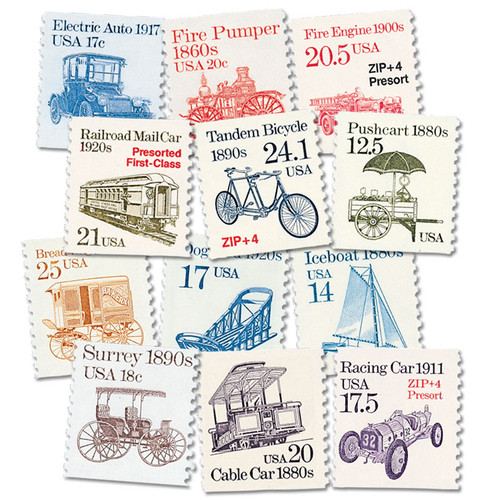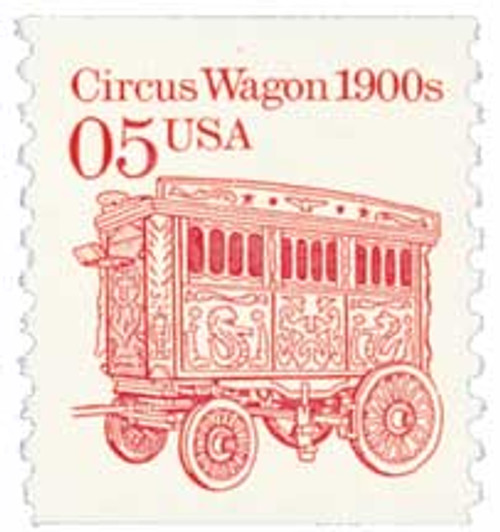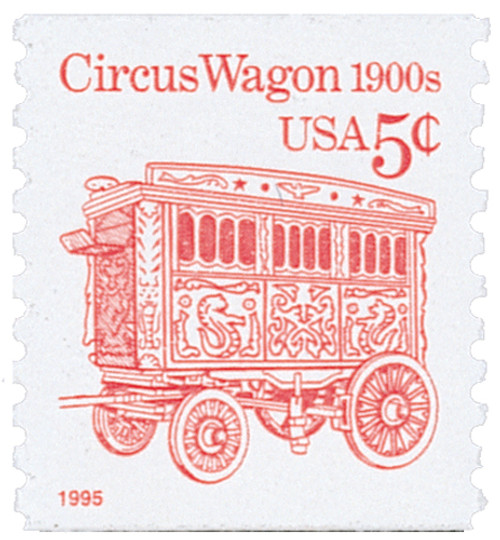
# 2452B - 1992 5c Transportation Series: Circus Wagon 1900s (white background)
US #2452B
1992 Circus Wagon 1900s
- Part of Transportation Series
- Reissue of 1990 stamp
Category of Stamp: Definitive
Set: Transportation Series
Value: 5¢
First Day of Issue: December 8, 1992
First Day City: Cincinnati, Ohio
Quantity Issued: 150,000,000
Printed by: American Bank Note Company
Printing Method/Format: Photogravure, coils of 10,000
Perforations: 10
Reason the stamp was issued: This is a reissue of a 1990 stamp. It was issued in coils of 10,000 for bulk mailings. This denomination in larger rolls was requested by the Disabled American Veterans to use on their fundraising mail.
About the stamp design: Susan Sanford created the image for the original Circus Wagon 1900s stamp that was used again for this stamp. The artist used postcards from the Circus World Museum as her inspiration.
Special design details: The previous issue was printed using intaglio. The design of the new, gravure produced stamp differs slightly. The shading on the left side of the wagon is thicker and more uniform than on the previous stamp.
First Day City: The Disabled American Veterans is headquartered in Cincinnati. Since this organization would be a consumer of this stamp, this was chosen as the First Day city. There was no formal ceremony.
About the Transportation Series: On May 18, 1981, the USPS issued the first stamp in the Transportation Series, US #1907, picturing the Surrey, a doorless four-wheeled carriage. For the first time in US history, a coil stamp featured its own unique design rather than simply copying that of the current definitive stamp. Over 50 more coil stamps would be issued over the course of the next 15 years, each picturing a different mode of transportation. All of these types of transportation were used since American independence.
The various denominations provided face values to exactly match the rates for several categories of Third-Class mail (bulk rate and quantity-discounted mail). As the rates changed, new stamps with new values were added. Never before had a stamp series included so many fractional cent values.
The Bureau of Engraving and Printing printed most of the stamps in the Transportation Series, although private contractors printed a few. All but a few of the later stamps were produced by engraved intaglio. Differences in precancels, tagging, paper and gum provide a large number of varieties.
Scott Catalog separates the Transportation stamps into four groups. The stamps in the first group (#1897-1908) generally have the denomination in small type with a “c” next to it. These stamps were printed on the Cottrell rotary press, which joined together two plates to make a sleeve. The gaps between these plates created depressions where ink would collect and create joint lines on the stamps. Later issues were printed on a different press and didn’t have these joint lines.
The second group (#2123-36) had larger numbers with no “c.” The third group (#2252-66) was similar in appearance to the second group, but service inscriptions were added to the designs. These stamps also used a variety of paper and gum as well as different types of tagging. The fourth group (#2451-68) marked the end of fractional values. Now bulk mailers would use either the 5¢ or 10¢ stamp and then pay the difference from the actual postage rate.
The last stamp in the Transportation Series, the 20¢ Cog Railway, was issued on June 9, 1995, at the TEXPEX ’95 stamp show in Dallas, Texas. This marked the end of the largest US definitive series up to that time. Three new series would eventually replace it – American Transportation, American Culture, and American Scenes. Additionally, the Great Americans would go on to become the largest American definitive series.
History the stamp represents: In 1793, America’s first permanent circuses opened in Philadelphia and New York City. Traveling circuses were later organized, and the need for “big tops” and circus wagons arose. As circus owners began to advertise the arrival of their shows with grand street parades, the wagon became more ornate. Gilded lettering, elaborate paintings, and decorative woodwork were gradually added – contributing to the spectacle which enticed patrons to the circus grounds. The circus wagon shown on the stamp is typical of those used during the first decade of the 1900s.
US #2452B
1992 Circus Wagon 1900s
- Part of Transportation Series
- Reissue of 1990 stamp
Category of Stamp: Definitive
Set: Transportation Series
Value: 5¢
First Day of Issue: December 8, 1992
First Day City: Cincinnati, Ohio
Quantity Issued: 150,000,000
Printed by: American Bank Note Company
Printing Method/Format: Photogravure, coils of 10,000
Perforations: 10
Reason the stamp was issued: This is a reissue of a 1990 stamp. It was issued in coils of 10,000 for bulk mailings. This denomination in larger rolls was requested by the Disabled American Veterans to use on their fundraising mail.
About the stamp design: Susan Sanford created the image for the original Circus Wagon 1900s stamp that was used again for this stamp. The artist used postcards from the Circus World Museum as her inspiration.
Special design details: The previous issue was printed using intaglio. The design of the new, gravure produced stamp differs slightly. The shading on the left side of the wagon is thicker and more uniform than on the previous stamp.
First Day City: The Disabled American Veterans is headquartered in Cincinnati. Since this organization would be a consumer of this stamp, this was chosen as the First Day city. There was no formal ceremony.
About the Transportation Series: On May 18, 1981, the USPS issued the first stamp in the Transportation Series, US #1907, picturing the Surrey, a doorless four-wheeled carriage. For the first time in US history, a coil stamp featured its own unique design rather than simply copying that of the current definitive stamp. Over 50 more coil stamps would be issued over the course of the next 15 years, each picturing a different mode of transportation. All of these types of transportation were used since American independence.
The various denominations provided face values to exactly match the rates for several categories of Third-Class mail (bulk rate and quantity-discounted mail). As the rates changed, new stamps with new values were added. Never before had a stamp series included so many fractional cent values.
The Bureau of Engraving and Printing printed most of the stamps in the Transportation Series, although private contractors printed a few. All but a few of the later stamps were produced by engraved intaglio. Differences in precancels, tagging, paper and gum provide a large number of varieties.
Scott Catalog separates the Transportation stamps into four groups. The stamps in the first group (#1897-1908) generally have the denomination in small type with a “c” next to it. These stamps were printed on the Cottrell rotary press, which joined together two plates to make a sleeve. The gaps between these plates created depressions where ink would collect and create joint lines on the stamps. Later issues were printed on a different press and didn’t have these joint lines.
The second group (#2123-36) had larger numbers with no “c.” The third group (#2252-66) was similar in appearance to the second group, but service inscriptions were added to the designs. These stamps also used a variety of paper and gum as well as different types of tagging. The fourth group (#2451-68) marked the end of fractional values. Now bulk mailers would use either the 5¢ or 10¢ stamp and then pay the difference from the actual postage rate.
The last stamp in the Transportation Series, the 20¢ Cog Railway, was issued on June 9, 1995, at the TEXPEX ’95 stamp show in Dallas, Texas. This marked the end of the largest US definitive series up to that time. Three new series would eventually replace it – American Transportation, American Culture, and American Scenes. Additionally, the Great Americans would go on to become the largest American definitive series.
History the stamp represents: In 1793, America’s first permanent circuses opened in Philadelphia and New York City. Traveling circuses were later organized, and the need for “big tops” and circus wagons arose. As circus owners began to advertise the arrival of their shows with grand street parades, the wagon became more ornate. Gilded lettering, elaborate paintings, and decorative woodwork were gradually added – contributing to the spectacle which enticed patrons to the circus grounds. The circus wagon shown on the stamp is typical of those used during the first decade of the 1900s.




















